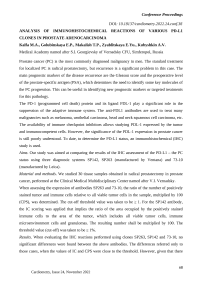Analysis of immunohistochemical reactions of various PD-l1 clones in prostate adenocarcinoma
Автор: Kalfa M.A., Golubinskaya E.P., Makalish T.P., Zyablitskaya E.Yu., Kubyshkin A.V.
Журнал: Cardiometry @cardiometry
Статья в выпуске: 24, 2022 года.
Бесплатный доступ
Prostate cancer (PC) is the most commonly diagnosed malignancy in men. The standard treatment for localized PC is radical prostatectomy, but recurrence is a significant problem in this case. The main prognostic markers of the disease recurrence are the Gleason score and the preoperative level of the prostate-specific antigen (PSA), which determines the need to identify some key molecules of the PC progression. This can be useful in identifying new prognostic markers or targeted treatments for this pathology.
Короткий адрес: https://sciup.org/148326332
IDR: 148326332 | DOI: 10.18137/cardiometry.2022.24.conf.38
Текст статьи Analysis of immunohistochemical reactions of various PD-l1 clones in prostate adenocarcinoma
Medical Academy named after S.I. Georgievsky of Vernadsky CFU, Simferopol, Russia
Prostate cancer (PC) is the most commonly diagnosed malignancy in men. The standard treatment for localized PC is radical prostatectomy, but recurrence is a significant problem in this case. The main prognostic markers of the disease recurrence are the Gleason score and the preoperative level of the prostate-specific antigen (PSA), which determines the need to identify some key molecules of the PC progression. This can be useful in identifying new prognostic markers or targeted treatments for this pathology.
The PD-1 (programmed cell death) protein and its ligand PDL-1 play a significant role in the suppression of the adaptive immune system. The anti-PDL1 antibodies are used to treat many malignancies such as melanoma, urothelial carcinoma, head and neck squamous cell carcinoma, etc. The availability of immune checkpoint inhibitors allows studying PDL-1 expressed by the tumor and immunocompetent cells. However, the significance of the PDL-1 expression in prostate cancer is still poorly understood. To date, to determine the PD-L1 status, an immunohistochemical (IHC) study is used.
Aims . Our study was aimed at comparing the results of the IHC assessment of the PD-L1 – the PC status using three diagnostic systems SP142, SP263 (manufactured by Ventana) and 73-10 (manufactured by Leica).
Material and methods . We studied 30 tissue samples obtained in radical prostatectomy in prostate cancer, performed at the Clinical Medical Multidisciplinary Center named after V.I. Vernadsky.
When assessing the expression of antibodies SP263 and 73-10, the ratio of the number of positively stained tumor and immune cells relative to all viable tumor cells in the sample, multiplied by 100 (CPS), was determined. The cut-off threshold value was taken to be ≥ 1. For the SP142 antibody, the IC scoring was applied that implies the ratio of the area occupied by the positively stained immune cells to the area of the tumor, which includes all viable tumor cells, immune microenvironment cells and granulomas. The resulting number shall be multiplied by 100. The threshold value (cut-off) was taken to be ≥ 1%.
Results. When evaluating the IHC reactions performed using clones SP263, SP142 and 73-10, no significant differences were found between the above antibodies. The differences referred only to those cases, when the values of IC and CPS were close to the threshold. However, given that there are differences and poor knowledge on this issue, we believe that further validation studies with larger cohorts are needed.
The work was financially supported within the framework of the state order No FZEG-2020-0060 of the Ministry of Education and Science of the Russian Federation in the field of scientific activity on the topic "Algorithms for the molecular genetic diagnosis of malignant neoplasms and approaches to their targeted therapy using cellular and genetic technologies."


